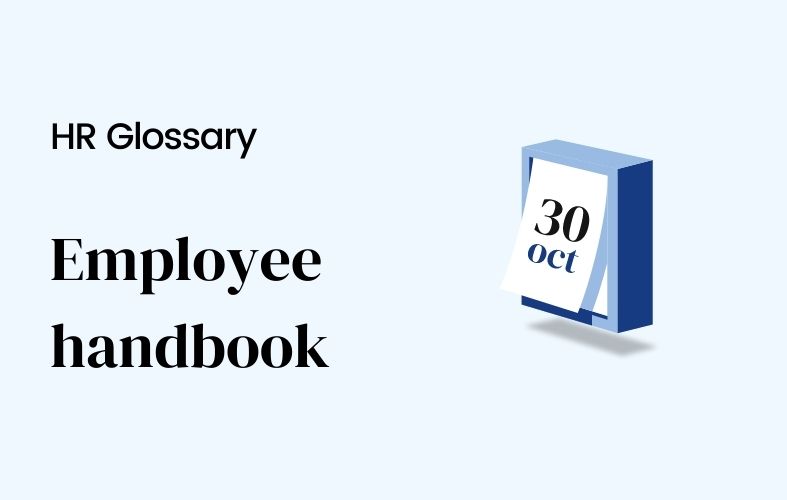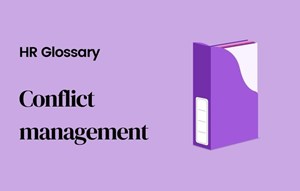Employee Handbook

[Sommaire]
What is an employee handbook?
An employee handbook is a document that gives employees guidance and information about an organization, provides advice on policies and procedures, and shares details about an organization’s culture. They are sometimes known as employee manuals, staff handbooks, and company policy manuals.
Employee handbooks are normally given to new employees as part of their onboarding or orientation. They provide employees with a ready reference to use as they settle into a company and allow them to digest important details at their own pace.
It is important to understand what an employee handbook is not. It is not an employment contract, nor is it a free pass for employers to pass any liability for wrongdoing onto an employee.
Why should you have an employee handbook?
A strong employee handbook can help employers as much as it can help employees.
Employee handbooks help organizations by :
- Clearly outlining expectations for employee behavior. This minimizes the potential for workplace disputes and sets the scene for what you believe to be acceptable and unacceptable.
- Giving managers a clear reference they can use to understand employment laws and company policy. This frees HR from responding to queries and makes managers’ jobs easier.
- Making it easier to onboard employees. HR managers and line managers do not need to spend a long time detailing all policies because the handbook includes the necessary information.
- Proving you took action to explain expectations, policies, and legal constraints to your employees. This can be especially important if you find yourself in an employment tribunal or similar.
Employee handbooks help employees by :
- Providing a consistent and authoritative source of information about your policies (such as those regarding harassment, discrimination, and data protection), procedures, and expectations. Employees who are in doubt about the appropriateness of a proposed action can check the handbook for advice.
- Giving employees information about how to report policy violations.
- Helping employees on board at their own pace. It can be given to new staff members as part of their onboarding process, allowing them to read and digest the information in their own time.
When should a company create an employee handbook?
There is no set time for when a company should create a manual for employees, but it is generally advisable to do so before hiring employees. This will ensure that all new employees receive the same information and prevent any confusion about their expectations.
How often should a company update its employee handbook?
A company should update its employee handbook examples as often as necessary to ensure that it remains accurate and up-to-date. However, it is generally advisable to do so at least once per year or whenever significant changes to company policies are made.
What should be included in an employee handbook?
When writing a manual for employees, there are several must-haves. The SHRM recommends a list of contents that includes the following items:
- Organizational information: This could include your company rules, company's history, mission statement, company culture, values, purpose, company equipment, company property, and equal employment opportunity commission statement.
- Details of policies: This will include details of all your policies. These would include subjects such as harassment, overtime, internet use, and use of social media.
- Details of benefits: This will include all potential benefits an employee could be entitled to. Suppose there is a big difference in benefits between groups of employees or departments. In that case, you may wish to create several handbooks to account for the different benefits these different groups are entitled to.
- Details of your commitment to safety: This would include occupational employee health insurance and safety requirements, personal protective equipment, and medical services. This includes standards of conduct and your exit process.
- Acknowledgment of receipt: You must get a signed acknowledgment of receipt from each employee as proof that you have provided them with this important information. Including a tear-out page that the employee signs are an easy way to do this.
What are the most important policies of an employee manual?
Employment basics:
This section of your employee manual should include the following topics:
- Position descriptions
- Probationary Periods
- Work Schedule and Hours
- Compensation and Overtime Pay
- Employee Status Changes
- Employment law and regulations
Workplace policies:
This section should include the following topics:
- Workplace safety
- Discrimination and harassment
- Nondisclosure and conflict of interest
- Employee leave policies
- Employee discipline
- Employee termination policy
Code of conduct:
This section should include the following topics:
- Workplace conduct and ethics
- Social media and technology use
- Employee dress code
Compensation and development:
This section should include the following topics:
- Employee performance reviews
- Employee development and training
- Promotions and salary increases
Benefits and perks:
This section should include the following topics:
- Employee benefits
- Employee discounts
- Employee recognition and Incentives
Working Hours, PTO and Vacation:
This section should include the following topics:
- Standard work hours
- Paid time off (PTO)
- Vacation and holidays
- Employee absences and leave
- Telecommuting and remote work policy
Employee Resignation and Termination:
This section should include the following topics:
- Employee resignation
- Employee termination
- Final paychecks
What to do if an employee breaks the rules?
If an employee breaks one of your company's rules, you will need to take disciplinary action.
This could include a verbal warning, written warning, or even dismissal from the company. You will need to outline the disciplinary process in your handbook to inform employees to be aware of what a new employment relationship can expect if they break the rules.
How to write an employee handbook?
The Society for Human Resource Management has a helpful guide that outlines the steps you need to take to write employee handbooks.
1. Assess your needs:
The first step is to assess your organization's specific needs. You should consider the size of your organization, its culture, the types of employees you have, and the benefits you offer. You should also consider any legal requirements that apply to your organization.
2. Gather information:
Once you have a good understanding of your needs, you can begin gathering the necessary information. This would include your organizational information, policy details, and benefits information.
3. Write the handbook:
Once you have gathered all the necessary information, you can begin writing on the employee handbook template. Make sure to include a table of contents so that employees can easily find the information they are looking for.
4. Have the handbook reviewed:
Once you have finished writing the handbook, you should have it reviewed by a lawyer or other expert to make sure that it is accurate and up-to-date.
5. Distribute the handbook:
Once the handbook has been reviewed and updated, you can distribute it to your employees. Make sure to get a signed acknowledgment of receipt from each employee as proof that they have received the handbook.
6. Review and update the handbook regularly:
Employee handbooks should be reviewed and updated on a regular basis to ensure that they accurately reflect the organization's current policies and procedures.


